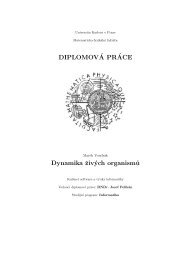Bachelor Thesis - Computer Graphics Group
Bachelor Thesis - Computer Graphics Group
Bachelor Thesis - Computer Graphics Group
You also want an ePaper? Increase the reach of your titles
YUMPU automatically turns print PDFs into web optimized ePapers that Google loves.
1. the most naive idea is the user of a timer (QTimer or SetTimer), invoking<br />
a handler routine in periodic intervals. This procedure would determine<br />
the mouse cursor position (GetCursorPos) and check whether<br />
the individual mouse buttons are pressed (GetAsyncKeyState). This<br />
solution is very inefficient and unreliable. Events can be lost between<br />
two consequent polling intervals. However, the biggest and unavoidable<br />
shortcoming is the inability to filter mouse events, rendering this option<br />
useless<br />
2. the second idea is to use Raw Input API [23] introduced in Windows<br />
XP. After registering for input notifications by calling the RegisterRaw-<br />
InputDevices function, our application would receive WM INPUT<br />
events, generated directly by the mouse. However, there is the same<br />
critical problem that we are not able to filter these events<br />
3. DirectInput [19] is another option, although not a good one. It is<br />
primarily meant to be used in games. When initialized in the exclusive<br />
mode, our program would receive all the mouse input events, while no<br />
other application gets any. This is a bad idea. All the standard mouse<br />
messages supposed to be send by Windows would have to be generated<br />
manually and routed to the corresponding windows<br />
4. hooks [26] are the right choice. When set, a specified callback function<br />
will be called on every mouse input event. The function decides whether<br />
to swallow the message or pass it to the affected window. The first<br />
available hook type - WH MOUSE LL may seem to be the best as it<br />
does not involve a library injection. The callback function is located in<br />
the hooking application. Nevertheless, this means that context is being<br />
switched between the hooked and hooking application on every event.<br />
This makes this hook type quite inefficient. If used, every single mouse<br />
cursor movement would cause two extra context switches. Therefore,<br />
the second alternative, WH MOUSE hook type has been chosen as the<br />
final solution. A library containing the callback function is injected into<br />
the address space of all applications running in the current login session.<br />
The function is called directly before the message reaches the window<br />
procedure, hence no context switch is involved<br />
5. subclassing [25] has also been considered as a potential alternative to<br />
hooks. By replacing the original window procedure, we can process all<br />
messages including the mouse events and decide whether to pass them<br />
to the previous window procedure, effectively implementing a filtering<br />
mechanism. But this approach is very problematic, a library containing<br />
our window procedure has to be loaded into the target process by some<br />
kind of code injection technique [38, 8]. Separate procedure variants<br />
have to be written for both ANSI and Unicode window types. The<br />
window procedure has to be replaced for all windows separately. Another<br />
hook type - WH SHELL, would have to be used to detect new window<br />
creation<br />
21
















